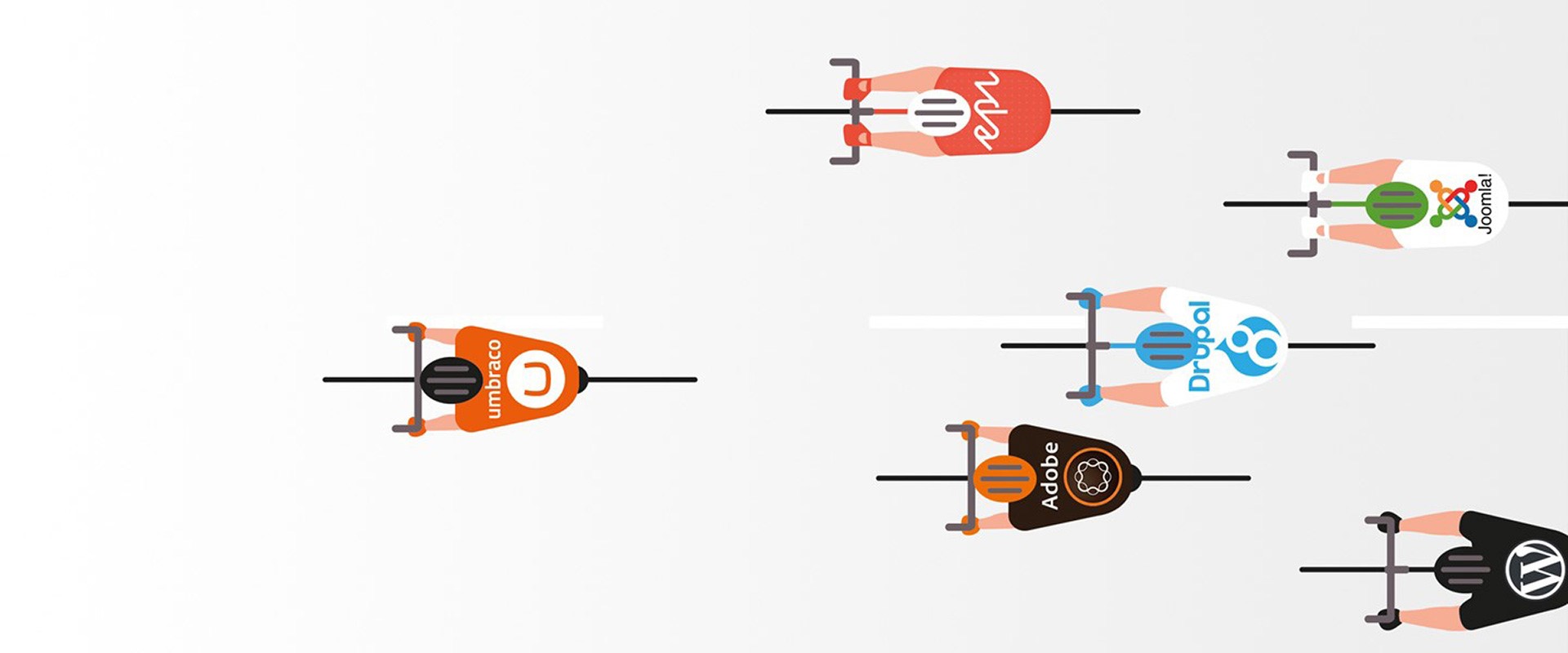As we often find ourselves discussing the merits of various CMS [content management systems] with our clients and prospects specifically in comparison to the Umbraco platform which we implement, we thought it would be a good idea to provide a quick summary of the key issues to consider and the options when looking at a new CMS.
What are the main options?
There are lots of proprietary content management systems, such as Episerver and Adobe Experience to name just two, that are really excellent, high-end products but that come with some pretty hefty licence fees and associated restrictions that mean that they’re only really viable for larger businesses. Alternatively, there are many ‘Open Source’ platforms which don’t have licence fees so are free to use, for example WordPress and Drupal. Wordpress is the most widely used by far, but partially because of its popularity, has some implications.
WordPress sites can be very quick and, therefore, cheap to implement as there are lots of free or cheap templates and plugins available. However, Wordpress is ultimately an adapted blogging platform so it’s consequently limited in terms of functionality, and whilst the third party templates can look good, they’re not bespoke so you will see many sites using the same design. There are many cheap resources and add ons too, but whilst a five dollar plugin from some Russian developer may seem like a cheap and therefore attractive solution, there’s generally a reason. We’ve had to sort out many security breaches and hacks often caused by the quality of code or even built in vulnerabilities for hackers to exploit. Ultimately the two cliches of ‘buyer beware’ and ‘you get what you pay for’ are truisms.
What’s Umbraco?
Umbraco is also an Open Source CMS, so there are no licence fees. It was built ground-up in Denmark about 17 years ago, growing into a mass user platform now implemented in over half a million websites. It offers great functionality and flexibility as it can be extended into an integrated site that can feed content to other digital assets or multiple sites making it very cost effective to develop on. Built in Microsoft’s industry-leading .Net framework, it uses the Microsoft ‘stack’, Microsoft Windows servers, and benefits from the core security protection built into that system, something it then builds on.
Many of the other CMS on the market restrict you in the way you can create pages. There can be a lot of functionality but, in turn, they force you to include a lot of HTML code, which they need in order to render out content. Because Umbraco is cleaner, without the extra HTML, the pages perform better in web searches as there’s less material for the systems to go through and they also load quicker. Umbraco is a pure CMS so you create the content and edit the content. At the front end you can access all the content which can be placed anywhere on a page, giving a granular level of design detail and complete flexibility.
Having access to the source code in Umbraco is a major advantage over proprietary systems which have license fees and an annual support package on top. If there is a problem with a proprietary system it can take a lot of time to resolve, and if your business needs any unique functionality then you’re into a world of very expensive bespoke work which can only be undertaken by the product’s developers. Because we can access the source code, our developers can create any custom features or functionality needed and if there’s an issue we can restore full service quickly. As Certified Partners we work closely with Umbraco and the Umbraco community, so if there is an issue with the source code itself we share it with Umbraco who will include it in the next update so the whole user community benefits as quickly as possible.
Is it secure?
No system is 100% secure, in fact nothing on the internet is, and you should probably avoid anything that makes that claim – but the combination of scale and a highly engaged development community means that issues are patched swiftly and Umbraco itself is committed to ensuring the platform remains secure as it grows. Just because WordPress is so popular it makes it a big target for attacks as a breach of it would be more valuable. As Umbraco continues to grow it knows it will inevitably attract more attention, which is why it has put a lot of effort into building a collaborative community.
Developers who identify weaknesses in security work on patches and submit them so everyone can benefit. The Umbraco security team is, in effect, the entire developer community. Issues identified by internal penetration or security tests are all shared by both businesses and agencies. Umbraco also future proofs its security by stripping out any vulnerable old code. By doing this it closes loopholes in redundant code that malicious programmes or individuals could try to exploit. By keeping the code clean it makes it easier to identify and fix future weaknesses. On top of this is the security protection offered through the Microsoft servers on which Umbraco is built.
Umbraco also launched a Cloud based solution recently, so the focus on security has increased as they’re now competing in the cloud storage space with proprietary CMSs. They recognise that success depends on their reputation so they need to ensure that their security is as good as it can be, which is of course great news for users of the platform.
What can’t it do?
We believe that there’s nothing you can imagine that we can’t create in Umbraco, given the time and therefore the budget! There’s complete freedom to create anything within the platform. Through iterative development, the user interface for editors and the CMS itself have improved a lot bringing more flexibility to create custom controls, which was once a really difficult thing to do. The Umbraco community has also added a lot of functions for editors into the CMS and there have been some quite interesting ones which we use to add flexibility when we create websites or apps using the interface.
Is it easy to use?
The best endorsement is the feedback we get from users. Our clients are always impressed by the Umbraco CMS because it combines ease of use with the ability to do so much. When we train clients on how to use the Umbraco interface, it’s always really easy to do because people understand the concept behind the pages. Basically, as an editor, if you can use Word you can use Umbraco.
“I recently went through Umbraco training at bd2 and was really impressed with how easy it is to use the system and to add or change content. In fact I’ve become a bit addicted to it and keep logging in to refresh the content in our US site well into the small hours!”
Matt Ousby, Design Director, Senator Group.
“I’ve recently added all the content to our site- text, images, video - and can’t believe how easy it’s been to use Umbraco. bd2 have developed lots of really cool features for us. It lets me completely update content whenever I want and I can even update content to be published another day, which is super helpful in our busy environment. I am delighted bd2 offered Umbraco to us, I wouldn’t want to go back to any other site ”
Eleanor Wood, Digital Marketer, 3P Logistics.
From an admin point of view, editors have full control. Umbraco’s user types means they can give junior staff rights access and the ability to create content but they can’t hit the publish button. Instead they can only save it and send it to an admin editor. The editor gets an alert to let them know some content requires checking then they can review it and publish it. There’s also a full audit log of every change on every page so the editors have the reassurance that they can see who has made changes and when.
Why choose bd2?
bd2 are Certified Umbraco Partners, all our developers are Umbraco trained and Certified and we attend the annual Codegarden event in Copenhagen to keep abreast of all the latest developments from Umbraco and those within the community. We’ve been implementing Umbraco for over 8 years and found it to be a CMS that allows us to create websites of any scale or function, it’s really simple to keep content updated giving users the power to add great content, it’s supported by a community constantly working on security, and doesn’t come burdened with huge license fees.

